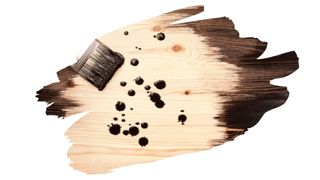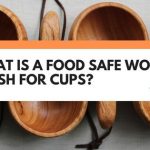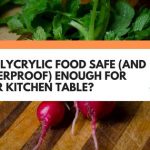When it comes to wood finishing a cutting board, food safety should be your top priority.
A food-safe wood finish can prevent harmful bacteria from thriving on your kitchen countertop. However, food safe does not mean it’s also safe enough to eat your dinner off of.
So, in this article, we cover why almost all varnishes are classed as food safe. You’ll also learn why food safe finishes do not mean that they’re approved for direct food contact.
And we reveal which non-toxic wood finish is wholly safe enough to be used on cutting boards.

This post may contain affiliate links to products that we receive a commission for (at no additional cost to you). Learn more here.
What Exactly Is Varnish Made From?
Varnish is a catch-all term used to describe a type of wood finish recipe. Rather than referring to any specific finish, its a term used interchangeably to refer to any number of glossy sealers.
For example, lacquers, shellac and even some exterior polyurethane finishes are sometimes marketed as a ‘varnish’. However technically, a varnish is any wood finish that mixes drying oils, resins, drying additives and chemical solvents.
The chemical solvents are mostly there to be a fast-acting drier, allowing resins and oils to solidify onto the surface of wood. And once a varnish coat cures, it forms a clear and durable water-resistant sealing coat.
So, Is Clear Varnish Food Safe?
Any wood finish that dries, cures and solidifies into a hard material, can arguably be called a food safe finish.
But, the key to a food safe finish lies in it wholly curing.
When varnish dries, it’s going through an evaporation process that changes it from a liquid into a solid film. But, underneath it’s surface film, that varnish is still drying out and evaporating. That is why a ‘dry’ varnish still has a whiff of fumes about it. Those fumes, also referred to as VOC’s (volatile organic compounds), are those evaporating solvent gasses being released into the air.
Now, a varnish isn’t food safe until it has gone through a chemical process that changes it into its final hard resinous form. And that process is called curing.
Curing takes much longer than drying. It can take anywhere from 1 to 4 weeks for varnishes to cure, (depending on the climate). However, a cured food safe wood finish is not the same thing as a food grade wood finish.
Related Post: Varnish Not Drying? (How To Fix That Sticky Varnish Problem)
What’s The Difference Between Food Safe And Food Grade?
Food grade finishes are safe enough to come in ‘direct’ contact with food. These finishes tend to contain ingredients that are fit for human consumption. And they do not contain any toxic chemicals that could possibly leech into food.
On the other hand, a food safe finish is safe enough to come in ‘indirect’ contact with food. Which means that — after wholly curing — it is no longer secreting resins or releasing fumes. So, that means there’s little chance of a cured varnish finish getting into any nearby food.
Now, the reason why food safe varnishes are only suitable for indirect food contact, is because they aren’t wholly insurmountable. Some types of cured varnish finishes can dissolve if they come into contact with alcohol or vinegar.
That’s why a food safe varnish, (or indeed any food safe finish), must not come into direct contact with hot food and liquids. In other words, you must not use a food safe finish to seal something like a wooden spoon or spatula.
Related Post: Can You Apply Shellac Over Varnish? (Best Practice Revealed!)
So, Can’t I Use Food Safe Varnish On My Cutting Board?
No, but not only because varnish is an indirect-food-contact finish.
You shouldn’t use varnish to seal a cutting board because of the way cutting boards are used. And there are two important reasons why we don’t use varnish finishes on a cutting board;
1). Varnishes Can Be Damaged When You Prepare Food On That Cutting Board
All of that chopping, cutting, and slicing, means that a varnish finish is going to be more of a hindrance than a help.
If you chop hard enough, you can easily cut through even cured varnish. And those finely sliced cuts will turn your water-resistant varnish into a sieve. Which means that raw meat liquids, and moisture, will soak into the wood underneath.
That moisture will cause hardwood chopping blocks to dry out and crack. But, more worryingly, it can expose you to the greater risk of food poisoning, due to the cross-contamination of raw meat.
2). Cutting Boards Need A Food Grade (Not Merely A Food Safe) Wood Finish
There are plenty of food safe finishes out there that are arguably better for wood than a varnish coat. Finishes such as Tung oil, Linseed oil, Danish oil and Polyurethane. All of those finishes, just like varnish, can be classed as food safe.
But, chopping blocks need a food grade finish, not just a food safe one. Which is why 100% pure food-grade mineral oil is the best finishing option for your cutting board.
This penetrating oil finish is non-drying, non-toxic and enhances wood grain brilliantly. It doesn’t decay or go rancid, as it is made from refined petroleum distillate. And best of all, it is water-repellent, helping to protect wood by making wood fibers less water absorbent.
Mineral oil finishes are much easier to apply and maintain than a varnish finish. And you won’t need to wait long (after application) to begin using your chopping block. You can begin using a cutting board within 24 hrs of an application of mineral oil.
And What Is Mineral Oil Exactly?
Mineral oil is made from petroleum. This is the same stuff found in diesel and white spirits.
Now, there are many different types of mineral oil products, such as Paraffin oil for example. However, food-grade mineral oil is not toxic at all, because this particular mineral oil version has been thoroughly filtered and refined.
Food grade mineral oil is widely used as a non-drying wood preserving finish. And you can buy it from most local stores and pharmacies.
Related Post: Walnut Oil Vs Mineral Oil: Which One’s Better For Your Cutting Board?
To Wrap Up, Here Are The 3 Key Takeaways From This Post…
- 1). A varnish wood finish is food safe only after it has wholly finished curing.
- 2). Varnish is not a food grade finish. So, varnish is only suitable for coating wooden surfaces that will have indirect contact with food.
- 3). For a food grade wood finish, (suitable for butcher blocks and cutting boards), use 100% pure food grade mineral oil.
References:
FDA Compliant, Food Grade and Food Safe | Industrial Specialties Mfg. & IS MED Specialties



